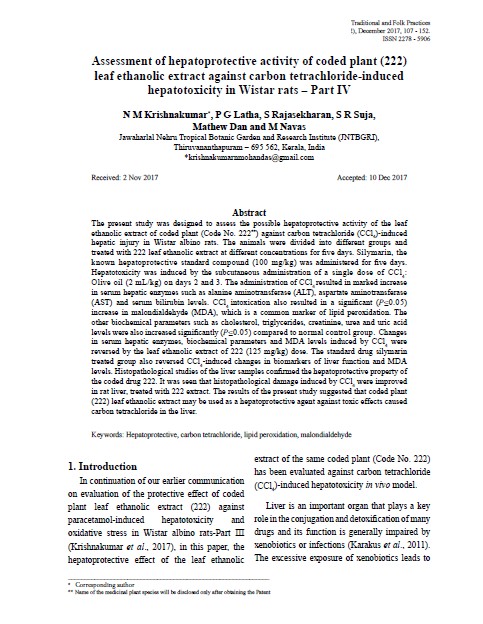Assessment of hepatoprotective activity of coded plant (222) leaf ethanolic extract against carbon tetrachloride-induced hepatotoxicity in Wistar rats – Part IV
Keywords:
Hepatoprotective, carbon tetrachloride, lipid peroxidation, malondialdehydeAbstract
The present study was designed to assess the possible hepatoprotective activity of the leaf ethanolic extract of coded plant (Code No. 222**) against carbon tetrachloride (CCl4)-induced hepatic injury in Wistar albino rats. The animals were divided into different groups and treated with 222 leaf ethanolic extract at different concentrations for five days. Silymarin, the known hepatoprotective standard compound (100 mg/kg) was administered for five days. Hepatotoxicity was induced by the subcutaneous administration of a single dose of CCl4: Olive oil (2 mL/kg) on days 2 and 3. The administration of CCl4 resulted in marked increase in serum hepatic enzymes such as alanine aminotransferase (ALT), aspartate aminotransferase (AST) and serum bilirubin levels. CCl4 intoxication also resulted in a significant (P≤0.05) increase in malondialdehyde (MDA), which is a common marker of lipid peroxidation. The other biochemical parameters such as cholesterol, triglycerides, creatinine, urea and uric acid levels were also increased significantly (P≤0.05) compared to normal control group. Changes in serum hepatic enzymes, biochemical parameters and MDA levels induced by CCl4 were reversed by the leaf ethanolic extract of 222 (125 mg/kg) dose. The standard drug silymarin treated group also reversed CCl4-induced changes in biomarkers of liver function and MDA levels. Histopathological studies of the liver samples confirmed the hepatoprotective property of the coded drug 222. It was seen that histopathological damage induced by CCl4 were improved in rat liver, treated with 222 extract. The results of the present study suggested that coded plant (222) leaf ethanolic extract may be used as a hepatoprotective agent against toxic effects caused carbon tetrachloride in the liver.


